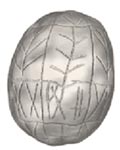

THE
CORE OF THE SCRIPT CONSISTS OF ABOUT THIRTY ABSTRACT ROOT-SIGNS EXPRESSING
MOST OF THE FUNDAMENTAL GEOMETRICAL FORMS.


Parallel
lines, various types of crosses, Vs opened by a vertical segment, trees
of life, Ys, Hs… A mysterious spherical stone, found in Lepenski
Vir (Yugoslavia) and 7500 years old, inscribed with root-signs
of proto-European script. The surface has horizontal and vertical lines
engraved on it: a kind of map of the world divided into meridians and
parallels. Most of the grid sections are covered with script signs, the
rest are completely empty.
Shan Winn (1981) hypotheses that a rod was inserted in the sphere to rotate it. We are perhaps looking at the oldest documentation on the use of writing for oracular purposes.
Shan Winn (1981) hypotheses that a rod was inserted in the sphere to rotate it. We are perhaps looking at the oldest documentation on the use of writing for oracular purposes.
According to Gimbutas (1991), the ancient European script consisted of about thirty core signs which were originally abstract and arbitrary or had gradually become so (V, /\, X, M, Y, N, cross, triangle, lozenge, zigzag, spiral, square...), while the rest of the script consists of derivative signs (formed by adding one, two, or three lines to the core signs, or by duplicating or inverting two or more core signs). According to Haarmann's inventory (1995) there were
10 basic signs that created new individual signs by undergoing simple or complex variations, and another 131 which remained unaltered. These root-signs express most of the basic geometric forms and they continued to be used until the classical Greek period.